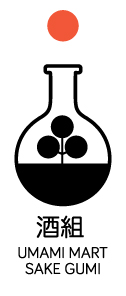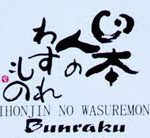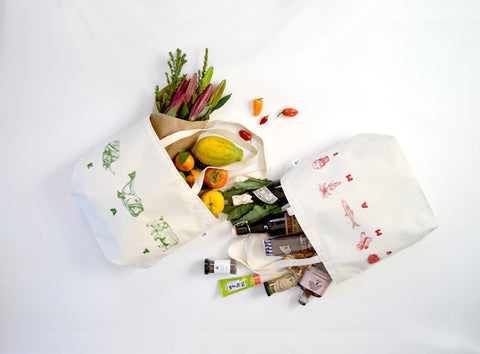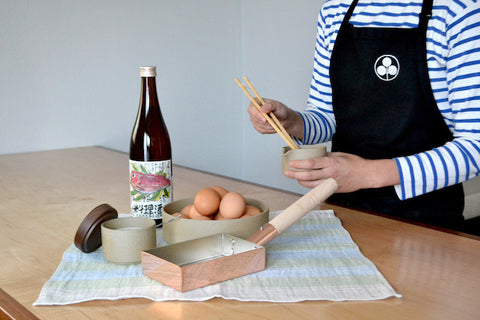 December sakes ship today for Sake Gumi, our monthly sake subscription club. If you like what's on deck here, you should join!
funk·y
\'fuŋ-kē\
adjective
December sakes ship today for Sake Gumi, our monthly sake subscription club. If you like what's on deck here, you should join!
funk·y
\'fuŋ-kē\
adjective1. Having or using a strong dance rhythm, in particular that of funk.
2. Strongly musty.
3. Odd or quaint in appearance or feeling.
This year was funky. 2016 was full of unexpected events and happenings that threw us for a loop. The deaths of David Bowie and Prince, the emotional rollercoaster of the elections, and most recently, the Ghost Ship fire in Oakland, have put us in a major funk. At least on a local level, our community has proven its resilience and openness to work together and make change.
To reflect on 2016, we end Sake Gumi this year with sakes that defy expectations and are undeniably funky. Besides some obviously funky characteristics of the sakes this month, for example, mushroomy aromas or yeasty flavors, these sakes throw curveballs in how they’ve been brewed or produced – dancing to their own beat.
Yoko
10% of this month’s Sake Gumi subscription sales will be donated to “Fam1st Supporting the Victims of Ghost Ship Fire” organized by Fam1st Family Foundation.
10% of all sales made in our Oakland store on Saturday, December 17 will also be donated to this fund.
LEVEL 1: Introductory Membership (Two 300ml bottles)
 Rokkasen Junmai Godan-Jikomi Nigori
Rokkasen Junmai Godan-Jikomi Nigori
Rokkasen Co., Ltd. (Yamagata, Japan)
Seimaibuai: 70%
SMV: -15
When brewing sake, steamed rice,
kōji, water, and yeast cultures are combined to cause fermentation – but they are not combined all at once. Instead, the mixing is typically separated into three stages. However, this unique
nigori (unfiltered sake) goes through five stages. This yields a sweeter brew. That said, I perceive this nigori to have more umami up front than sweetness. Sip this sake
chilled and savor its earthy, melony sweetness, and fizz alongside foods that go well with champagne, like
crab and
oysters. Good riddance to 2016!
 Nihonjin no Wasuremono Junmai Yamahai
Nihonjin no Wasuremono Junmai Yamahai
Bunraku Sake Brewery (Saitama, Japan)
Seimaibuai: 60%
SMV: +5
If you’ve read the notes from last month, you will recognize this type of sake –
yamahai. Yamahai is a traditional style of making sake where lactic acid and yeast is drawn from the air instead of added into the fermentation mash. This yields a sake that is often richer, more umamiful, and yogurty. This particular sake is mild for a yamahai but has the creamy and nutty elements that are often present in this style. Its long finish is also worth savoring. With notes of cashews and cocoa, this sake is great
chilled alongside
grilled squid,
salmon, and perhaps worth trying alongside slices of
bottarga.
LEVEL 2: Premium Membership (Two 720ml bottles)
 Bunzaemon Junmai Ginjo
Bunzaemon Junmai Ginjo
Bunzaemon Koga (Saga, Japan)
Seimaibuai: 55%
SMV: +3
I love this
junmai ginjo because it throws you for a loop. I typically expect a junmai ginjo to be fruity and crisp, but this junmai ginjo has an assertive cream-of-mushroom nose that is savory and robust enough to be enjoyed
warm (junmai ginjos are most often enjoyed cold). Because this is a sturdy sake full of shiitake and enoki-aromas, go ahead and pair it with heavy holiday party foods like bacon-wrapped
asparagus and
creamy, cheesy dips.
 Kakeya Junmai Muroka Nama Genshu
Kakeya Junmai Muroka Nama Genshu
Takeshita Honten Co, Ltd. (Shimane, Japan)
Seimaibuai: 70%
SMV: +4
This self-proclaimed “Umami Sake” sums up how I feel about 2016. It was unfiltered (
muroka), undiluted (
genshu), and raw (
nama), so it is fitting that it was brewed in 2016. Recently available in the U.S., this special bottle uses rice grown locally in Shimane and features the skill of the brewery’s 78-year-old
toji (brew-master) who has been refining his craft since he was 18. Savor notes of raisin, mouth-watering acidity, and a cedar nose – all best highlighted when
chilled. Skipping dilution provides structure while the muroka style leaves the sake with a light, golden hue, since it is not filtered through charcoal. Try this sake with a rich meal fit for a celebration, like
lobster or
herb-roasted duck. 2016 is almost over: YAY!
 December sakes ship today for Sake Gumi, our monthly sake subscription club. If you like what's on deck here, you should join!
December sakes ship today for Sake Gumi, our monthly sake subscription club. If you like what's on deck here, you should join!
 Rokkasen Junmai Godan-Jikomi Nigori
Rokkasen Co., Ltd. (Yamagata, Japan)
Seimaibuai: 70%
SMV: -15
When brewing sake, steamed rice, kōji, water, and yeast cultures are combined to cause fermentation – but they are not combined all at once. Instead, the mixing is typically separated into three stages. However, this unique nigori (unfiltered sake) goes through five stages. This yields a sweeter brew. That said, I perceive this nigori to have more umami up front than sweetness. Sip this sake chilled and savor its earthy, melony sweetness, and fizz alongside foods that go well with champagne, like crab and oysters. Good riddance to 2016!
Rokkasen Junmai Godan-Jikomi Nigori
Rokkasen Co., Ltd. (Yamagata, Japan)
Seimaibuai: 70%
SMV: -15
When brewing sake, steamed rice, kōji, water, and yeast cultures are combined to cause fermentation – but they are not combined all at once. Instead, the mixing is typically separated into three stages. However, this unique nigori (unfiltered sake) goes through five stages. This yields a sweeter brew. That said, I perceive this nigori to have more umami up front than sweetness. Sip this sake chilled and savor its earthy, melony sweetness, and fizz alongside foods that go well with champagne, like crab and oysters. Good riddance to 2016!
 Nihonjin no Wasuremono Junmai Yamahai
Bunraku Sake Brewery (Saitama, Japan)
Seimaibuai: 60%
SMV: +5
If you’ve read the notes from last month, you will recognize this type of sake – yamahai. Yamahai is a traditional style of making sake where lactic acid and yeast is drawn from the air instead of added into the fermentation mash. This yields a sake that is often richer, more umamiful, and yogurty. This particular sake is mild for a yamahai but has the creamy and nutty elements that are often present in this style. Its long finish is also worth savoring. With notes of cashews and cocoa, this sake is great chilled alongside grilled squid, salmon, and perhaps worth trying alongside slices of bottarga.
LEVEL 2: Premium Membership (Two 720ml bottles)
Nihonjin no Wasuremono Junmai Yamahai
Bunraku Sake Brewery (Saitama, Japan)
Seimaibuai: 60%
SMV: +5
If you’ve read the notes from last month, you will recognize this type of sake – yamahai. Yamahai is a traditional style of making sake where lactic acid and yeast is drawn from the air instead of added into the fermentation mash. This yields a sake that is often richer, more umamiful, and yogurty. This particular sake is mild for a yamahai but has the creamy and nutty elements that are often present in this style. Its long finish is also worth savoring. With notes of cashews and cocoa, this sake is great chilled alongside grilled squid, salmon, and perhaps worth trying alongside slices of bottarga.
LEVEL 2: Premium Membership (Two 720ml bottles)
 Bunzaemon Junmai Ginjo
Bunzaemon Koga (Saga, Japan)
Seimaibuai: 55%
SMV: +3
I love this junmai ginjo because it throws you for a loop. I typically expect a junmai ginjo to be fruity and crisp, but this junmai ginjo has an assertive cream-of-mushroom nose that is savory and robust enough to be enjoyed warm (junmai ginjos are most often enjoyed cold). Because this is a sturdy sake full of shiitake and enoki-aromas, go ahead and pair it with heavy holiday party foods like bacon-wrapped asparagus and creamy, cheesy dips.
Bunzaemon Junmai Ginjo
Bunzaemon Koga (Saga, Japan)
Seimaibuai: 55%
SMV: +3
I love this junmai ginjo because it throws you for a loop. I typically expect a junmai ginjo to be fruity and crisp, but this junmai ginjo has an assertive cream-of-mushroom nose that is savory and robust enough to be enjoyed warm (junmai ginjos are most often enjoyed cold). Because this is a sturdy sake full of shiitake and enoki-aromas, go ahead and pair it with heavy holiday party foods like bacon-wrapped asparagus and creamy, cheesy dips.
 Kakeya Junmai Muroka Nama Genshu
Takeshita Honten Co, Ltd. (Shimane, Japan)
Seimaibuai: 70%
SMV: +4
This self-proclaimed “Umami Sake” sums up how I feel about 2016. It was unfiltered (muroka), undiluted (genshu), and raw (nama), so it is fitting that it was brewed in 2016. Recently available in the U.S., this special bottle uses rice grown locally in Shimane and features the skill of the brewery’s 78-year-old toji (brew-master) who has been refining his craft since he was 18. Savor notes of raisin, mouth-watering acidity, and a cedar nose – all best highlighted when chilled. Skipping dilution provides structure while the muroka style leaves the sake with a light, golden hue, since it is not filtered through charcoal. Try this sake with a rich meal fit for a celebration, like lobster or herb-roasted duck. 2016 is almost over: YAY!
Kakeya Junmai Muroka Nama Genshu
Takeshita Honten Co, Ltd. (Shimane, Japan)
Seimaibuai: 70%
SMV: +4
This self-proclaimed “Umami Sake” sums up how I feel about 2016. It was unfiltered (muroka), undiluted (genshu), and raw (nama), so it is fitting that it was brewed in 2016. Recently available in the U.S., this special bottle uses rice grown locally in Shimane and features the skill of the brewery’s 78-year-old toji (brew-master) who has been refining his craft since he was 18. Savor notes of raisin, mouth-watering acidity, and a cedar nose – all best highlighted when chilled. Skipping dilution provides structure while the muroka style leaves the sake with a light, golden hue, since it is not filtered through charcoal. Try this sake with a rich meal fit for a celebration, like lobster or herb-roasted duck. 2016 is almost over: YAY!




Comments (0)
There are no comments for this article. Be the first one to leave a message!